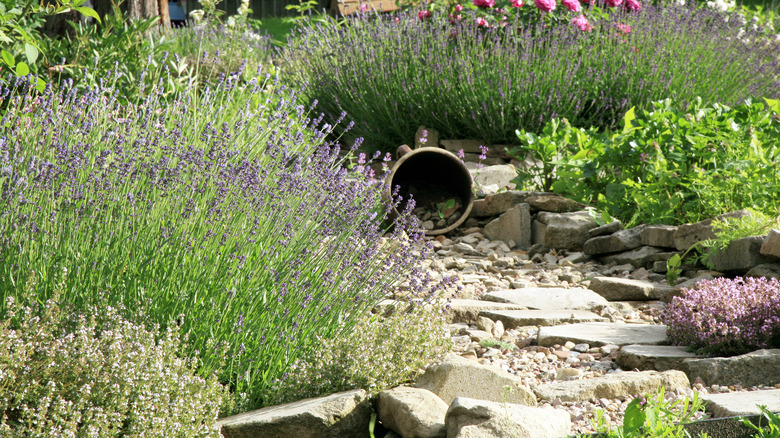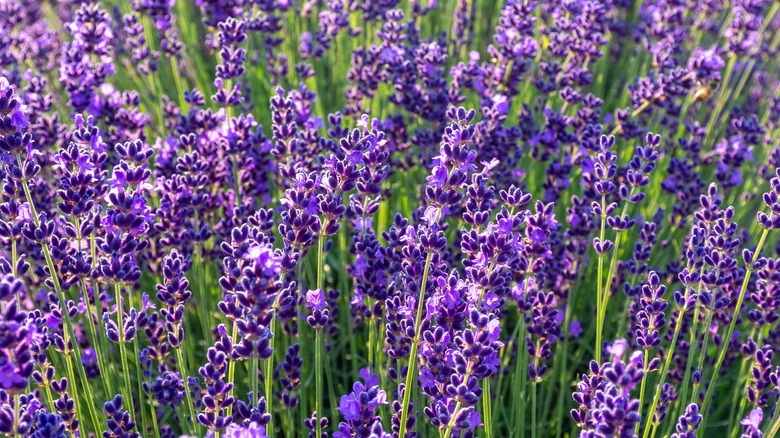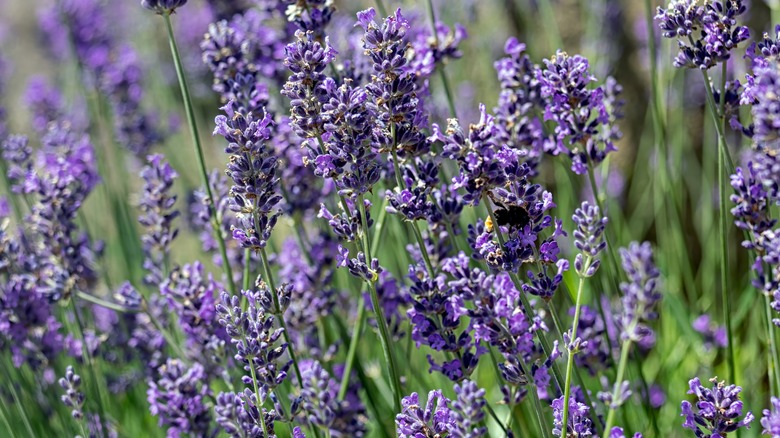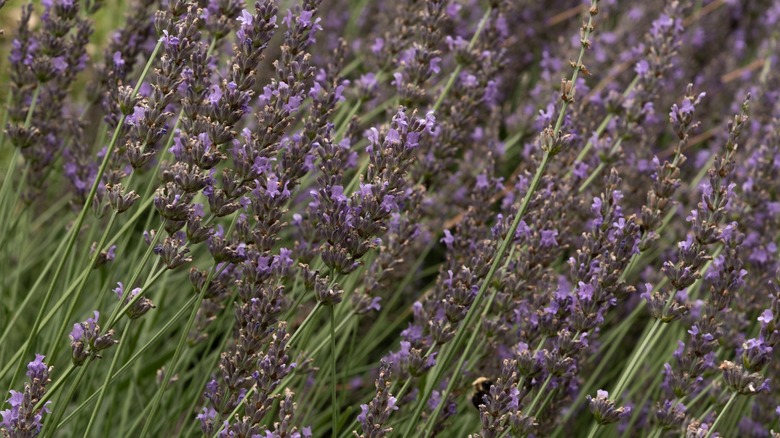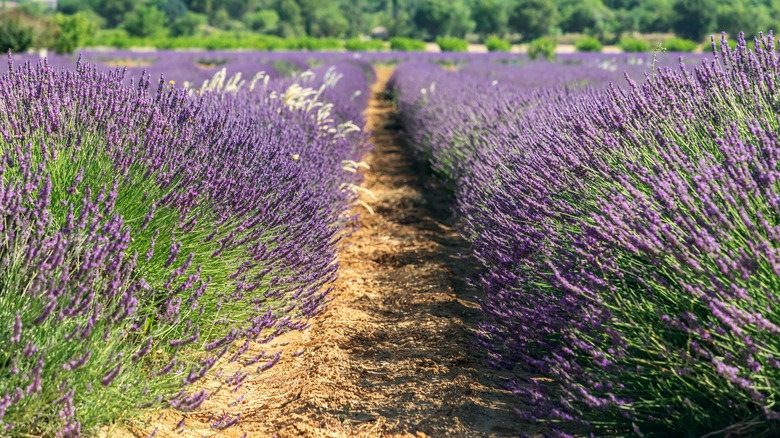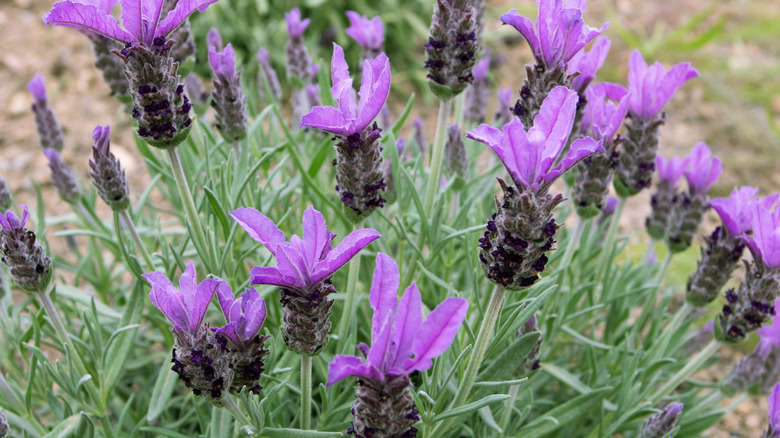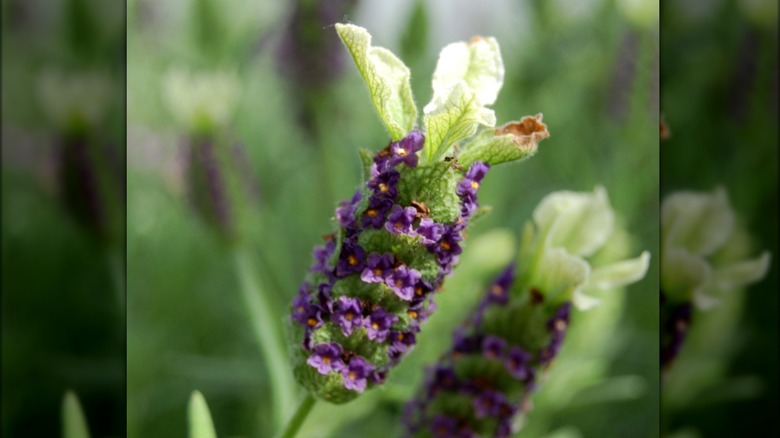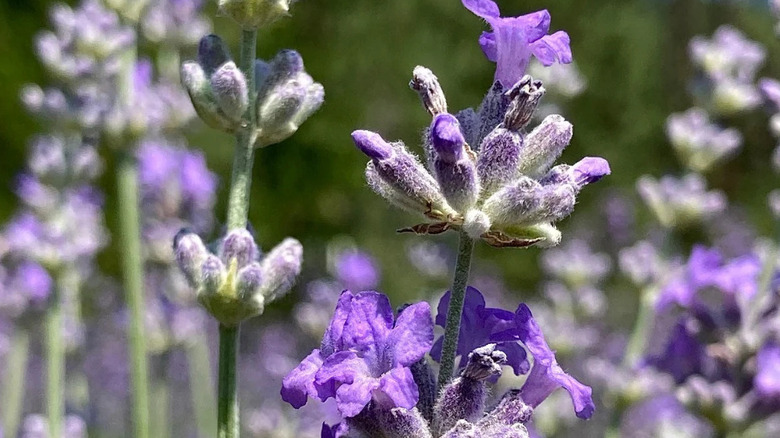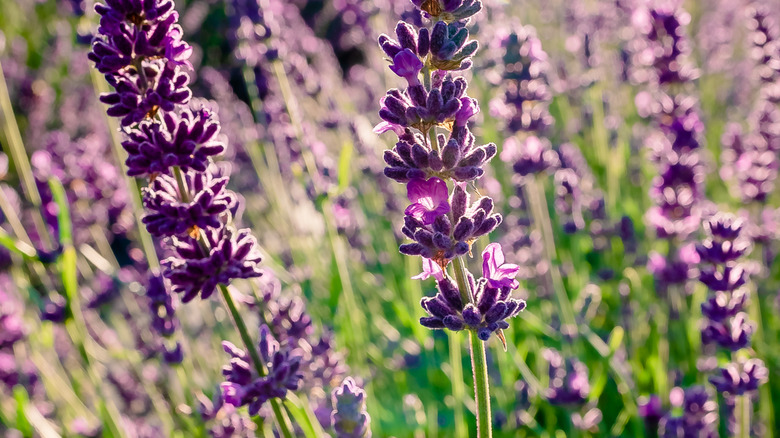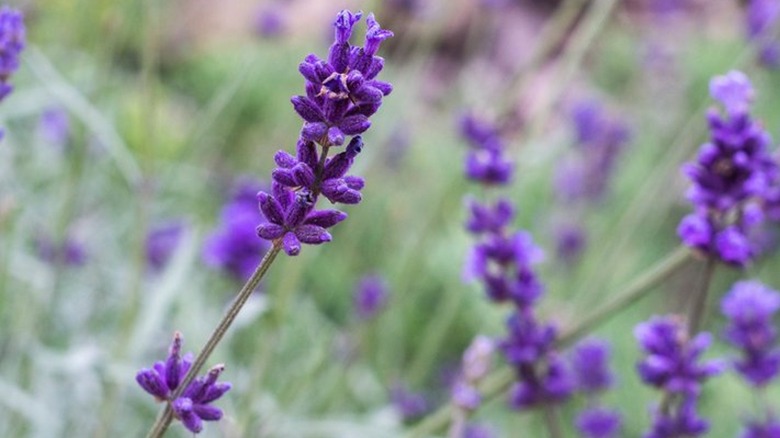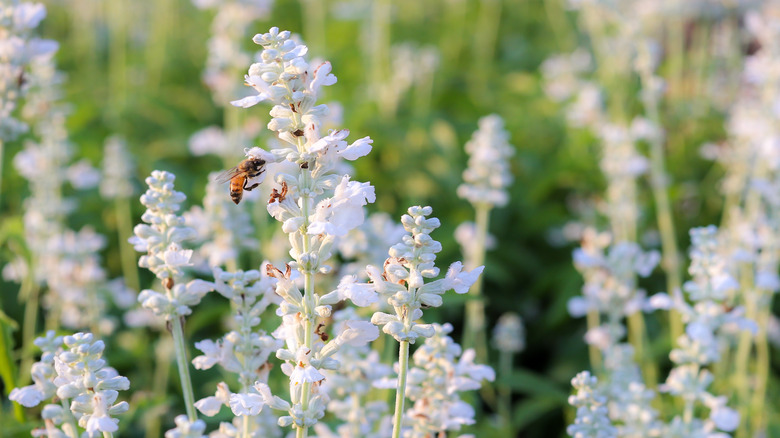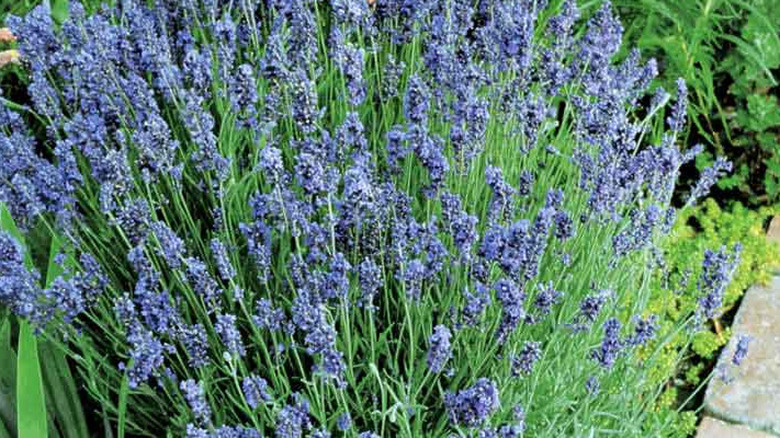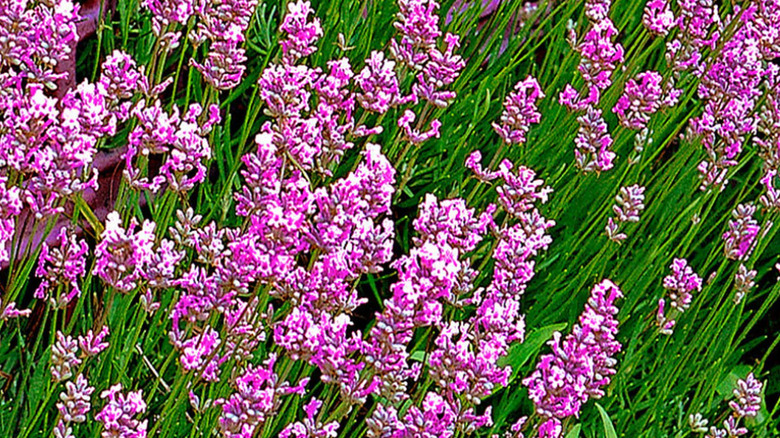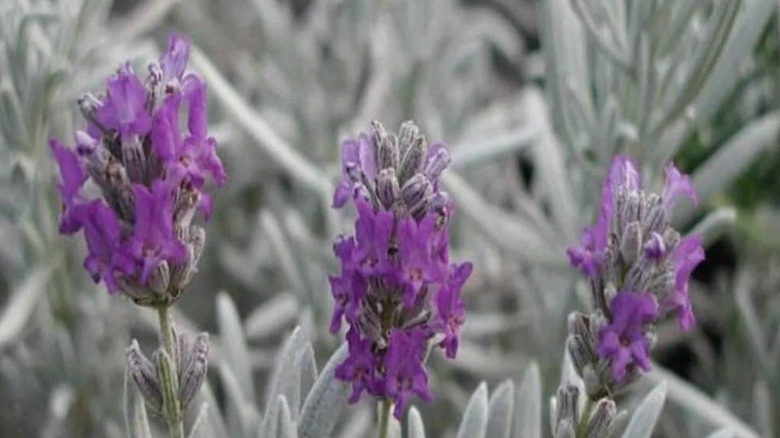13 Stunning Lavender Varieties That You Can Plant Together For An Aesthetic Garden
Lavender has a rich history and has been cultivated for use as a medicinal herb, a culinary ingredient, and a beauty supplement for thousands of years. Today, lavender is an enormously popular garden plant, which adds both beauty and a sweet scent to the landscape. This herb is not only a treat for the senses; it also offers advantages to the garden. According to the University of Illinois Chicago Heritage Garden, lavender is "beneficial for the garden because it attracts non-invasive insects, which then help manage the invasive insect population. The plant is also less prone to pests and diseases than other herbs and vegetables, which can cut down on pesticide and fungicide usage."
With nearly 50 different species and over 400 varieties to choose from, it's easy to feel overwhelmed when selecting lavender plants for your garden. If you live in USDA zones 5 through 9, most lavender plants should do well in your outdoor space. Fortunately, you don't need to narrow your options down to just one, because various varieties of lavender pair perfectly together to achieve a visually stunning and practical space. Plant Spanish and French lavender varieties like Fathead and Pretty Polly together for a floral display that thrives in high levels of heat and dry conditions, or consider choosing Loddon Pink and Arctic Snow for an unusual pink and white color combination. Here are some of the most gorgeous lavender varieties that can be planted alongside each other for a beautiful garden.
1. Create a scented sensory garden with Hidcote
Lavender is renowned for its sweet yet woody aroma, and one of the strongest scented varieties is Hidcote. Hidcote is an English lavender cultivated for its intensely aromatic oil. It is the perfect plant for growing alongside seating areas where the perfume can be enjoyed. Pair it with other heavily fragranced English lavender such as Fulgate and Munstead for a scented sensory garden. Brittnay Haag, University of Illinois Extension horticulture educator agrees, stating, "Lavender would be an exceptional plant for a sensory garden with its silver, feathery foliage and wonderful, soothing scent."
2. Munstead is one of the hardiest varieties of lavender
If you're looking for a hardy lavender to grow in your yard then English lavender is undoubtedly the best option, suitable for USDA hardiness zones 5 to 10. However, there are numerous options to choose from. One of the hardiest varieties is Munstead. Dr. Stephanie Burnett, University of Maine associate professor of horticulture, found that Munstead was the hardiest variety in test trials, though she indicated Phenomenal was believed to be even more hardy, surviving in zone 4. For a striking floral display in cooler climates, plant these two varieties together.
3. Phenomenal is resistant to common diseases
As well as being one of the hardiest varieties of lavender, Phenomenal also stands out as one type of lavender that is resistant to common diseases known to affect these herbs. Hailing from the Lavandin group of lavenders, which are hybrids resulting from crossing English lavender (Lavandula angustifolia) and Portuguese lavender (Lavandula latifolia), Phenomenal will not succumb to root and foliar diseases that trouble most other types of lavender. It is also tolerant of high levels of humidity, making it an ideal choice for humid environments.
4. Plant French Grosso to attract pollinators to the garden
University of Missouri Extension horticulturist Jennifer Schutter says, "Fresh lavender plants will keep a garden fragrant as well as attract a variety of pollinators like bees, butterflies, praying mantis, and others. In urban settings where the population of natural pollinators is on a decline, lavender plants offer an invaluable attraction to these species." A study published by the British Ecological Society indicated that hybrid Lavandula × intermedia varieties were more attractive to pollinators, such as French Grosso. Grow these pollinator-friendly plants for a wealth of bees and butterflies in the garden.
5. Spanish Fathead lavender can bloom all year long
Cultivating a range of different lavender varieties can ensure a longer blooming time, providing fragrance and color in the garden. Spanish lavender is known for its long blooming season, but some varieties of this lavender species can even bloom all year long in the right conditions. One of the most stunning Spanish lavender plants is Fathead, aptly named after its plump, deep purple flowers. Grown in USDA hardiness zones 8 to 9, Fathead will flower continuously from early spring to late summer, with another flourish of blooms appearing in fall.
6. Enjoy supreme drought tolerance with Pretty Polly
In hot and dry climates, most types of lavender will thrive, but French and Spanish varieties are known to excel in these conditions. Pretty Polly is a striking Spanish lavender that performs best in USDA hardiness zones 8 to 10, and will survive with extended dry spells once established. Poor soil quality is no problem when growing these beautiful plants because they are accustomed to rocky and sandy soils. Create a gorgeous Mediterranean-inspired garden with Pretty Polly alongside other drought-tolerant Spanish lavender varieties.
7. For recurrent blooming, grow Irene Doyle lavender
If you want to enjoy a range of colors in your lavender garden, add some blue varieties to the mix. Irene Doyle is a popular blue-flowering type of aromatic herb that can add additional color and interest to the garden, with its ability to bloom twice each year. Irene Doyle is known for its high concentration of essential oil, making it a popular variety for commercial harvest, and for ensuring a strong scent when planted in the garden. Late spring is the best time to plant lavender for a sweet-smelling, vibrant garden.
8. Superblue lavender produces densely packed, vibrant blue blooms
Superblue is a popular variety of English lavender that produces an abundance of intensely blue flowers on short spikes. The compact nature of this plant makes for a striking impact, with densely packed blooms seemingly covering the entire upper half of the herb from spring through to late summer. At a maximum height of 12 inches, Superblue works well for container growing and small yards. Use this variety and its bushy growth habit to fill in gaps amongst your other lavender plants in the garden for a full and lush aesthetic.
9. Savor the heavy scent and deep purple spikes of Twickel Purple
Twickel Purple is a variety of English lavender that produces dark purple flowers on long, elegant spikes. Reaching up to around 30 inches in height, this plant works well as a low, fragrant hedge, or as a tiered border behind more compact lavender species like Superblue. The best spot in your garden to plant lavender is a sunny site with well-draining soil, and this holds true for Twickel Purple which favors full sun. Prune it in early to mid-spring for optimal flowering.
10. Create contrast with the white flowers of Arctic Snow
Most lavender plants produce blue or purple flowers, but there are a few exceptions, including Arctic Snow which blooms from mid to late summer. This variety of English lavender grows white flowers, which you may have been able to guess from its icy name. You can create stunning visual contrast with this variety by planting it alongside more typical types of lavender such as Hidcote and Munstead. Arctic Snow has a compact growth habit, making it ideal for container planting or smaller yards.
11. Award-winning Lady lavender will flower from seed in its first year
Lady is a cultivar of English lavender that was named the winner of the All-American Selection in 1994. It was chosen because of its unique ability to germinate from seed in just 14 to 28 days with a 78% success rate. It also blooms in its first year, making it the best lavender variety to grow if you want to start from seed but don't have the patience to wait until next season for flowers. Avoid overwatering to maintain a compact habit.
12. Grow Loddon Pink for compact pink flowers
This heavily scented variety of lavender makes a beautiful statement in the garden and will stand out from other types of more typical-looking lavender plants due to its unique coloring. With foliage that is more green than silver, and pale pink flowers that contrast against the leaves, Loddon Pink is a truly exceptional variety of lavender. It flowers late in the season, from July to September. Grow it alongside earlier flowering varieties like Fathead for an extended display of color. Loddon Pink can be used for low hedging, container growing, and borders.
13. Make your own potpourri with Boiss wooly lavender
Joe-Ann McCoy of North Carolina State University Extension says wooly lavender "is an exceptional potpourri plant because of its balsam-lavender fragrance." One variety of wooly lavender that's a good source of essential oil is Boiss, which makes it ideal for drying and producing homemade scented products. Grow Boiss in the garden to enjoy all season long, then prune off the flowers to use indoors. The best time to harvest lavender for optimal fragrance is late summer and early fall when the oils in the flowers are at their highest concentration.
